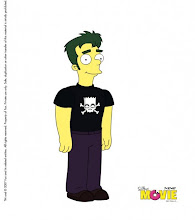
Do you own crap that was bought at three am from smiling, scary people on TV? Well here's a list of patents that actually exist. People thought they were good ideas then they thought people would want to buy them. Think about this but not too much.
Top 10 useless inventions
To inspire nominations for the Landfill Prize, here’s our list of the 19th and 20th centuries’ most unnecessary inventions
scream silencer
by John Naish
READ ARTICLE FROM TIMES ONLINE
What’s the most useless, pointless, resource-wasting consumer gadget that you have seen, bought or been given in the past 12 months?That’s the question at the heart of the first annual Landfill prize, which has already attracted a host of nominations, including automatic cucumber peelers, hi-spec plug-in air fresheners and a £150 electric toothbrush.
Today’s consumer society has become astonishingly adept at inventing pointless, hopeless, resource-sucking gizmos, but let’s not pretend we have a monopoly on this. Since the Victorian era, some of humankind’s most creative brains have kept themselves busy creating answers for needs that didn’t exist and solutions that are more cumbersome than the problems they promised to tackle. To inspire nominations for the Landfill Prize, here’s our list of the 19th and 20th centurys’ most pathetic, unnecessary and patently daft inventions.
1. The combined plow and gun
Patent no 35600, issued 1862
Rather than turn your sword into a ploughshare, why not combine your plough with a medium-sized artillery piece? It’s bound to be so much more effective than shouting “get orf moi land” at errant ramblers. Or, as the American inventor claimed, “Its utility is unquestionable, especially when used in border localities, subject to savage feuds and guerrilla warfare. In times of danger may be used in the field, ready charged with its deadly missiles of ball or grape. The share serves to anchor it firmly in the ground and enables it to resist the recoil, while the hand levers furnish convenient means of giving it the proper direction.” Why don’t the perpetually bickering Archers have one?
2. Device for waking persons from sleep
Patent no 256265, issued 1882
Sometimes, an alarm clock just isn’t quite enough for rousing heavy sleepers to face the day. So why not hang an array of weights on a frame above the snoozer’s head and, with the help of clockwork machinery, drop them upon their head until they wake? “When they fall it will strike a light blow, sufficient to awaken the sleeper, but not heavy enough to cause pain,” assures the inventor. Surely it’s just bound to cause stubborn sleepers simply to pull the duvet over their heads.
3. Balloon propelled by eagles or vultures
Patent no 863087, issued 1887
First, catch your eagle or vulture. Then attach the large bird to a balloon cupola, point its beak in desired direction, then sit back, relax and enjoy the in-flight snacks and movie. There’s a kind of simple genius to this idea, but a few potential snags make themselves apparent. Yes, there will be protests by animal lovers, but perhaps more pertinent is the fact that large birds of prey or carrion are notoriously uncooperative in matters of providing predictable and directable propulsion. Oh, and won’t they peck holes in the balloon?
4. Method of preserving the dead
Patent no 748284, issued 1903
Having trouble finding a suitable memorial for your loved one? How about having them permanently encased in glass? Herkimer J. Karkowski, the New Yorker who devised this tidy and decorative form of body-disposal seems to have been rather less squeamish than the average mourner. He believed that bereaved people would love nothing more than seeing their departed hermetically encased within a block of transparent glass, and thus “maintained for an indefinite period in a perfect and lifelike condition”. If an entire glass-encased relative might take up too much parlour-space, Karkowski suggested just having their head done. An attractive adornment to any mantelpiece. Or a handy doorstop? Glazed looks all round.
5. Moustache and lip guards
Patent no GB191127119, issued 1912
Oh the Edwardians and their moustaches: the damned hairy things seemed to be ever getting in the way, catching fire or becoming unattractively damp and potentially infected. To prevent this last problem, Fritz Baudisch filed a British patent to stop beards and moustaches getting moistened while drinking. His gadget consisted simply of a protective antiseptic paper disk that could be adapted to be folded over the edge of any drinking-vessel. Then, of course, it got damp and filled the toper’s facial hair with papier mache. Drat.
6. Water-filled brassiere
Patent no US4734078, issued 1988
All the mental effort expended on the mid 20th-century’s most famous innovations – the First and Second World Wars – seems to have fixed many inventors’ wilder imaginations on the straightforward business of creating new killing machines, thus draining their eccentric energy for several decades. It is only in the 1980s that we see a true return to form, with the creation of impractical and useless gadgetry like this – a sort of Wonderbra meets Waterworld. The American Inventor, James Moreau, explains it best (if it can be explained): “A brassiere which surrounds the breasts with water, so that a buoyant force provides improved and independent support for each breast. A transparent version is suggested for those who wish to make a fashion statement.” Even Madonna seems to have passed on that latter suggestion.
7. Sound-muffler for covering the mouth
Patent no 4834212, issued 1989
It’s the invention that really makes you want to scream – but no one will hear you. Moira and Frank Figone a couple from Belmont, California, created this face-tube device to enable purchasers to “Yell or scream without disturbing others, allowing them to vent built-up anger and frustration.” In this fiendishly basic design, the interior of the flat-bottomed muffler tube is coated with sound-absorbing foam. But here’s the clever bit: a microphone can be included to pick up a some sound and activate a light display or meter, “giving the user immediate visual feedback as to the intensity of sound produced”. Because otherwise, you’d never know, eh?
8. A glove for courting
Patent application no GB2221607, issued 1990
In the world of invention, romance is never dead. Just complicated. Terry King’s innovation aimed to assist couples who wish to maintain precious palm-to-palm contact while holding hands on cold days. It’s a pair of gloves knitted together into a single glove with a common palm section, but two separate sets of fingers. Bless. However, if you and your lovey-dove find yourselves running blissfully together through a frosty meadow and encounter a tree, the result could be distinctly face-mushingly tragic if you run either side of the trunk. That’s at least one good reason why the courting glove doesn’t seem to have caught on.
9. Alarm-equipped fork
US patent 5,421,089, issued 1995
Are you a manic masticator or a superfast food shoveller? The cutlery creators Nicole Dubus and Springfield Susan have come up with the just answer for you: a fork with a built in timer and alarm. The timer’s circuitry is connected to the handle of the fork and buzzes or lights up after a preset time, ensuring that eaters leave sufficient space between forkfulls for chewing 32 healthy times before swallowing. A must for business lunches and candlelit dinners.
10. The trouser-cushion
UK patent application No GB2267208, 1993
You may need to sit down for this one. British inventor Michael Bayley decided to put an end to standing nightmares by creating portable seat that you wear on a waist-belt. OK, it’s a somewhat convoluted version of having a cushion with a loop that goes through your belt. “The seat cushion is pivotable between a stowed position and a seating position in which it hangs down so that you can sit on it,” says the patent application. I can see one possible practical use: musical chairs, though you may get beaten to death by indignant toddlers.




0 comments:
Post a Comment